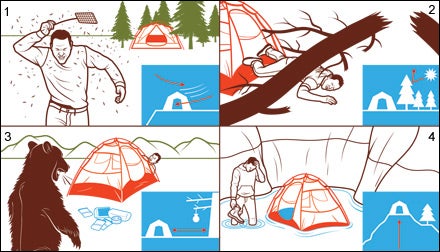1. WIND Because bugs prefer to congregate in wind eddies and calmer, forested areas, choosing a site on a windy point or somewhat open area will help keep them at bay. Plus, on warm evenings, a bit of a breeze will help keep you cool.
Bear Bag Hanging 101
(A) Find a pair of branches roughly 20 feet apart and 15 feet off the ground.(B) Tie one end of your P-cord to a small rock, the other end to an anchor (like a nearby tree trunk), and throw the rock over both branches.
(C) Use a stick to grab the cord (at least ten feet) between the branches and make a bight (a knotted loop) in the cord.
(D) Attach the food bag, hoist, and tie off.
Gear needed: 100 feet of P-cord
2. SHADE Look for it, especially if you’re planning on using the site as a base camp for a few days. And while big, tall trees are nice, make sure you don’t place your tent under a dead or dying onethey’re called
3. BEARS If you’re camping in bear country and don’t have bearproof food containers, make sure there’s a tree where you can hang your food. Alsoand this is doubly important in griz countryremember two things: (1) Keep food and food-scented clothes out of your tent, and (2) be sure to cook at least 100 yards downwind of where you’re sleeping.
4. ELEVATION “When in doubt, go higher.” Though aimed at climbers, The Mountain Gazette‘s famous motto applies to campsite selection as well. If bad weather unexpectedly moves in, the protected gully you pitched your tent in might become a river. And remember, cold air sinks, so low spots will be chillier.


